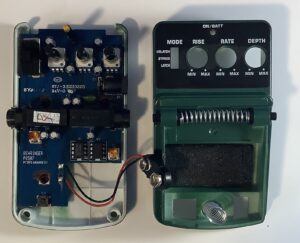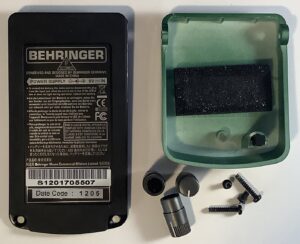You’ve probably been wondering where I’ve been. Or, not.
My latest gedanken experiment is a small, lightweight effect chain to add chorus and reverb after the 1010Music Tangerine. Tangerine is a great little sampler, but its effects processing is very basic. An external effects chain would make up for its shortcomings.
I’m a fan of Yamaha’s approach to the stage/combo keyboards. The Stage CP, Stage YC and CK have control-studded front panels. The effect chain is laid out in plain sight and knobs/switches control the most essential parameters. Internally, a host processor reads out the knobs/switches and pokes the tone generator hardwaare pipeline.
I’d like to have a similar interface using discrete effects (AKA “guitar pedals”) instead. Guitar pedals are built to a rugged standard adding size and weight, however. Most guitar multi-FX require a lot of menu-diving and I’d like to avoid that and discrete effect units put knobs/switches on top.
I looked into modular effects first. Unfortunately, the form factor (Eurorack) isn’t what I had in mind. Plus, modular requires a +12V/-12V power supply; good old +9V center negative (“pedal standard”) is cheap and readily available.
Instead of making a floor-standing pedal board, I want a box that resides comfortably on top of a controller keyboard. Rugged build is not required and therein lies an opportunity to reduce weight.
There are so many guitar pedals on the market that it doesn’t make sense to design and build the electronics from scratch. So, why not buy a few pedals and tear them down?
Now, nobody in their right mind will buy a bunch of expensive $400 pedals for scientific experiment. I did a quick survey of the bottom-feeder pedals — Mooer, Donner and Behringer. I put a Donner mini MOD pedal on order. Meanwhile, I got the itch to tear something apart.
Behringer tear down
The one thing I will say for Behringer, you can’t beat the price! They offer a wide range of discrete effect pedals for $25-$40 USD retail. Three or four pedals will run about $100 and that ain’t bad.
While waiting for the Donner to come in, I tore down a Behringer UV300 Ultra Vibrato. I used this pedal in a different project and it was time that it gave its life for science.
The UV300 comes apart without too much difficulty. If you have a Behringer pedal, you already know that the 9V battery compartment is hidden under the foot treadle. You’ve probably sworn a blue streak while trying to get the treadle back on after replacing the battery. 🙂 The 9V battery clip passes up through a hole in the main chassis top-plate. When you go to remove the plastic top, don’t forget to remove the knobs; the knobs press onto flatted potentiometer shafts.
Behringer pedals have some heft when you pick one up. Kind of surprising, because the chassis (case) is molded plastic. A heavy bottom-plate provides the heft. Once the metal bottom-plate is removed, the rest of the pedal assembly nearly floats away! Four screws attached the metal bottom-plate to the plastic chassis bottom-plate. The plastic bottom plate holds the printed circuit board (PCB) in place.
The foot treadle has a protruding stem on its bottom side. The stem pokes through a hole in the case top-plate and pokes a tactile switch on the PCB. Thus, Behringer gets away without a mechanical panel switch.
There you are. One could reduce a Behringer pedal of this type to its PCB and plastic bottom-plate without much difficulty thereby shedding a lot of weight. Not as compact as a custom PCB, but a few such assemblies could be housed in a small project box and are easily daisy-chained into a multi-effect with independent stages and controls.
Plus, it’s only $25 a stage!
BTW, IC1 is a CD3207GP (1024 stage BBD) and IC2 is a Coolaudio V3102D (Two-phase CMOS BBD clock generator).
Copyright © 2024 Paul J. Drongowski


